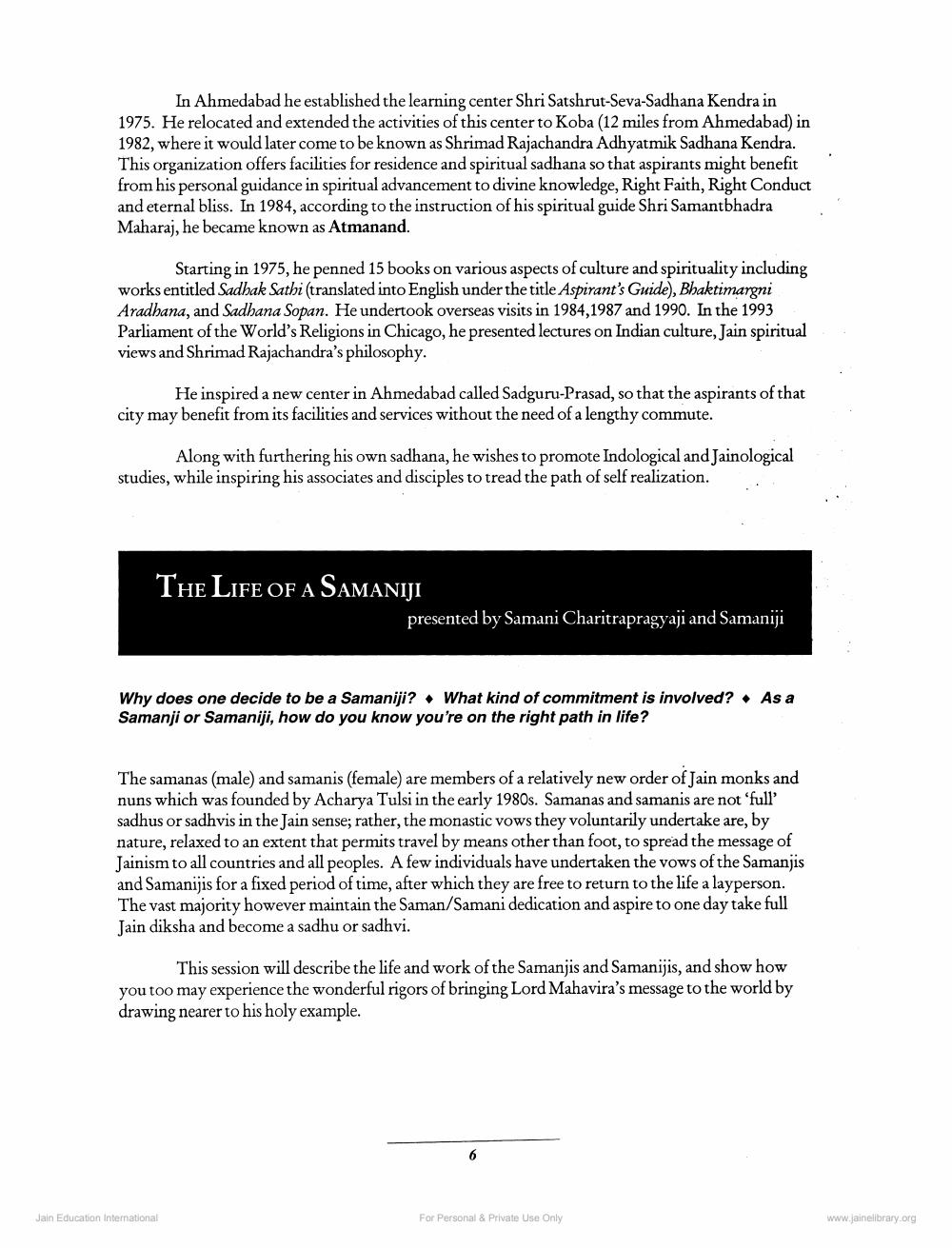Book Title: YJA Convention 2000 07 LA Fourth Author(s): Young Jains of America (YJA) Publisher: Young Jains of America YJA USA View full book textPage 8
________________ In Ahmedabad he established the learning center Shri Satshrut-Seva-Sadhana Kendra in 1975. He relocated and extended the activities of this center to Koba (12 miles from Ahmedabad) in 1982, where it would later come to be known as Shrimad Rajachandra Adhyatmik Sadhana Kendra. This organization offers facilities for residence and spiritual sadhana so that aspirants might benefit from his personal guidance in spiritual advancement to divine knowledge, Right Faith, Right Conduct and eternal bliss. In 1984, according to the instruction of his spiritual guide Shri Samantbhadra Maharaj, he became known as Atmanand. Starting in 1975, he penned 15 books on various aspects of culture and spirituality including works entitled Sadhak Sathi translated into English under the title Aspirant's Guide), Bhaktimargni Aradhana, and Sadhana Sopan. He undertook overseas visits in 1984,1987 and 1990. In the 1993 Parliament of the World's Religions in Chicago, he presented lectures on Indian culture, Jain spiritual views and Shrimad Rajachandra's philosophy. He inspired a new center in Ahmedabad called Sadguru-Prasad, so that the aspirants of that city may benefit from its facilities and services without the need of a lengthy commute. Along with furthering his own sadhana, he wishes to promote Indological and Jainological studies, while inspiring his associates and disciples to tread the path of self realization. THE LIFE OF A SAMANIJI presented by Samani Charitrapragyaji and Samaniji As a Why does one decide to be a Samaniji?. What kind of commitment is involved? Samanji or Samaniji, how do you know you're on the right path in life? The samanas (male) and samanis (female) are members of a relatively new order of Jain monks and nuns which was founded by Acharya Tulsi in the early 1980s. Samanas and samanis are not 'full' sadhus or sadhvis in the Jain sense; rather, the monastic vows they voluntarily undertake are, by nature, relaxed to an extent that permits travel by means other than foot, to spread the message of Jainism to all countries and all peoples. A few individuals have undertaken the vows of the Samanjis and Samanijis for a fixed period of time, after which they are free to return to the life a layperson. The vast majority however maintain the Saman/Samani dedication and aspire to one day take full Jain diksha and become a sadhu or sadhvi. This session will describe the life and work of the Samanjis and Samanijis, and show how you too may experience the wonderful rigors of bringing Lord Mahavira's message to the world by drawing nearer to his holy example. Jain Education International For Personal & Private Use Only www.jainelibrary.orgPage Navigation
1 ... 6 7 8 9 10 11 12 13 14 15 16 17 18 19 20 21 22 23 24 25 26 27 28 29 30 31 32 33 34 35 36 37 38 39 40 41 42 43 44 45 46 47 48 49 50 51 52 53 54 55 56 57 58 59 60 61 62 63 64 65 66 67 68 69 70 71 72 73 74 75 76 77 78 79 80 81 82 ... 88
